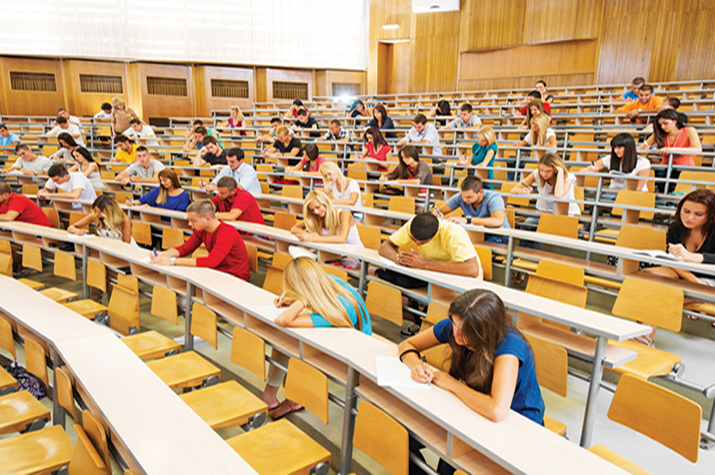Using active-learning approaches in a lecture hall
Active learning has emerged as an effective pedagogy in the science, technology, engineering and math disciplines. Active-learning approaches engage students through activities or discussions rather than having them listen passively in a lecture environment. In an active-learning classroom, students learn critical thinking, teamwork and problem-solving skills.
Recently, a meta-analysis of 225 studies showed that active-learning approaches improved student performance on exams or concept inventories and reduced failure rates compared with traditional lecture. Furthermore, active-learning interventions are especially effective for black and first-generation students. In the widely promoted 2009 American Association for the Advancement of Science report “Vision and Change In Undergraduate Education: A Call to Action”, in numerous reports by the National Research Council, and in the American Society for Biochemistry and Molecular Biology report to the Teagle Foundation, active-learning approaches are recommended in the STEM disciplines.

As a teacher, you may be interested in using active-learning approaches in your classroom but find yourself trapped in a lecture bowl. These rooms are designed for traditional lecture and are not conducive to discussions among students or interactions between students and teachers. Some universities have alternative classrooms featuring group seating and extensive technology to facilitate discussion, but not every teacher is so lucky as to have access to those. Many academic institutions do not have alternative classrooms, and resistance to active-learning approaches can be strong in some departments. Additionally, you may not feel ready to overhaul your course and may want to test out just a few techniques. Here are some strategies you can use to engage students without the need for alternative classroom space or extensive technology.
Think, pair and share
In this activity, each student completes a short assignment based on the day’s lecture. Upon completion, students trade assignments with those seated next to them and comment on each other’s work. The assignments are then returned to the students, who are allowed time to review the suggestions. The teacher then may call on a few pairs of students to summarize their findings.
This activity provides instant feedback for students at any point during class, allowing them to evaluate their own learning. In addition, students improve their communication skills and get a different perspective on the topic at hand. The final discussion by the instructor clarifies any misconceptions and summarizes the major points to be learned.
Simple quiz
In this quiz, the instructor asks a yes/no question to the class. All students respond with thumbs up or thumbs down, and a discussion of the correct answer led by the teacher follows. This quiz can be enhanced by the use of clickers, allowing for more complex questions. It can be used at the start of class to assess previous knowledge or throughout to monitor student comprehension.
This paperless quiz allows the instructor to determine the class’s mastery of a topic in a single glance. It also avoids the stress many students feel when speaking in front of a large class. This instant feedback allows instructors to accommodate the intellectual needs of students, correct misunderstandings and reinforce concepts in real time. Students benefit from the simple quiz as gaps in their understanding are revealed, indicating where to focus their studies.
Quick paper
The instructor asks participants to take two to three minutes during class to write about a topic or a question the teacher has asked. The prompt may be used at the start of class to focus students’ thoughts on the content of the day or later on to reinforce important concepts.
This activity also may be used to encourage student reflection on past and current knowledge, encouraging a transition to higher levels of learning. Instructors also may use the exercise to solidify student understanding of difficult or critical concepts or to bring class to a close, summarizing major points.
Case studies
The teacher gives pairs of students a scenario that applies concepts discussed in the lecture. Question design encourages students to make connections between the information learned and the provided situation. Student pairs may be called upon to share their work with the class or a nearby group. This flexible activity can be short, with only a few questions, or extended for a full session.
By applying their knowledge to a new situation, students achieve higher-ordered learning. In addition, group work challenges students to improve their teamwork and communication skills.
Note check
In this activity, a student shares his or her lecture notes with a partner or small group. This activity may be used to summarize the end of a lecture and confirm student comprehension of a lesson. Students also may use each other’s notes to create or answer problems.
The note-check technique is a rapid way to ensure students have caught the main points of the lecture. Additionally, it encourages students to look at the concepts from a different perspective. By answering or generating questions together, they transition to higher-level learning.
Doing problems together
Many students benefit from working out problems with the instructor. The teacher leads the class through a problem but stops for student participation now and then rather than completing the whole problem on his or her own.
This technique allows students to see a problem completed step by step and promotes student engagement by requiring participation to solve the problem.
Undergraduate teaching assistants
Teaching assistants can be of great help when implementing active-learning techniques. Especially in large classes, teaching assistants can monitor students during group activities and create more one-on-one interactions. Undergrads who have completed the course already can provide useful suggestions to their peers on strategies for success in the class as well as testing out potential class activities.
By implementing these strategies, amongothers, teachers can promote active learning in a traditional lecture setting. Techniques that use small-group work, reflection and peer critique enhance student engagement in a class that otherwise promotes passive learning.
The use of active-learning techniques, even in small amounts, has been proved to improve student performance in the STEM disciplines. Though you may be trapped in a lecture bowl, with these simple strategies, you can escape and create a class of engaged learners.
Enjoy reading ASBMB Today?
Become a member to receive the print edition monthly and the digital edition weekly.
Learn moreFeatured jobs
from the ASBMB career center
Get the latest from ASBMB Today
Enter your email address, and we’ll send you a weekly email with recent articles, interviews and more.
Latest in Careers
Careers highlights or most popular articles


Let’s make ASBMB awardees look more like BMB scientists
Think about nominating someone outside your immediate network.

Calendar of events, awards and opportunities
It's time to vote in the society's election, and time's running out to nominate colleagues for the ASBMB annual awards.

Calendar of events, awards and opportunities
Apply for our Advocacy Training Program by April 19. Plus, submit your entry for molecule of the year!

So, you went to a conference. Now what?
Once you return to normal lab life, how can you make use of everything you learned?

Touching the future from the bench
Scholar, scientist, teacher and mentor Odutayo Odunuga discusses the important roles of the institutional PI, his journey and his research.

